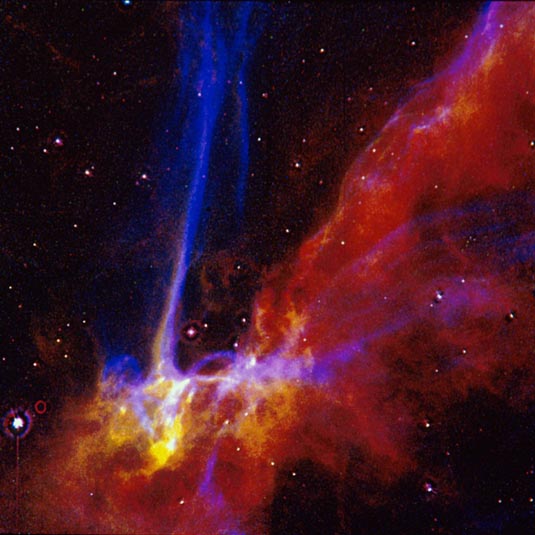
a Supernova's Blast Wave
Description: Supernova remnant
Position: RA: 20h 51m 27s Dec: 31° 07' 28"
Constellation: Cygnus
Distance: Approximately 2,600 light-years
Observation Date: April 24, 1991
Image Credit: NASA/J.J. Hester (Arizona State Univ.)
Release Date: January 6, 1993
ABOUT THIS IMAGE:
This is an image of a small portion of the Cygnus Loop supernova remnant, taken with the Wide Field and Planetary Camera on NASA's Hubble Space Telescope on April 24, 1991. This research was presented at the 181st Meeting of the American Astronomical Society in Phoenix, AZ on January 6, 1993, by Dr. Jeff J. Hester, of Arizona State University.
The Cygnus Loop marks the edge of a bubble-like, expanding blast wave from a colossal stellar explosion which occurred about 15,000 years ago.
The HST image shows the structure behind the shock waves in the Cygnus Loop with unprecedented clarity. This is allowing astronomers, for the first time, to compare directly the actual structure of the shock with theoretical model calculations. Besides supernova remnants, these shock models are important in understanding a wide range of astrophysical phenomena, ranging from winds in newly-formed stars to cataclysmic stellar outbursts.
The supernova blast wave is slamming into tenuous clouds of interstellar gas. This collision heats and compresses the gas, causing it to glow. The shock acts as a searchlight by revealing the structure of the interstellar medium.
Hubble's detailed image shows the blast wave overrunning dense clumps of gas. Though HST can reveal details about as small as our Solar System, the clumps are still unresolvable. This means that they must be small enough to fit inside our Solar System, making them relatively small structures by interstellar standards.
A bluish ribbon of light stretching left to right across the picture might be a knot of gas ejected by the supernoya. This interstellar "bullet," traveling over three million miles per hour (5 million km), is just catching up with the shock front (which has been slowed by plowing into interstellar material).
The Cygnus Loop appears as a faint ring of glowing gases about three degrees across (six times the diameter of the Full Moon), located in the northern constellation Cygnus the Swan. The supernova remnant is within the plane of our Milky Way Galaxy and is 2,600 light-years away.
Supernova remnants play an important role in stellar evolution by enriching space with heavy elements, and triggering new star formation by compressing interstellar gas.
Technical
Details: The photo is a combination of separate images taken in three
colors. Oxygen atoms (blue) emit light at temperatures of 30,000 to 60,000
degrees Celsius (50,000 to 100,000 degrees Fahrenheit). Hydrogen atoms
(green) arise throughout the region of shocked gas. Sulfur atoms (red)
form when the gas cools to around 10,000 degrees Celsius (18,000 degrees
Fahrenheit).